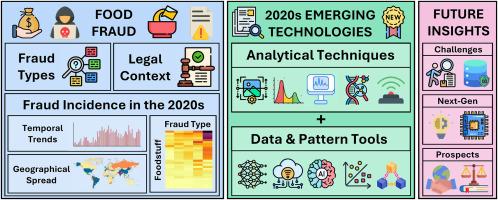检测食品欺诈的新兴技术:21世纪20年代现状回顾
IF 15.4
1区 农林科学
Q1 FOOD SCIENCE & TECHNOLOGY
引用次数: 0
摘要
食品欺诈是指为了经济利益而故意掺假或歪曲食品的行为。它已成为本世纪20年代日益严重的全球挑战,对公共卫生、消费者信心和经济产生重大影响。复杂的国际供应链、经济压力和COVID-19大流行暴露的脆弱性加大了欺诈行为的机会。范围和方法本文审查了新兴技术和食品数字化的最新进展,以解决食品欺诈问题。我们概述了先进的分析方法,包括光谱、成像、色谱、光谱技术、分子DNA分析和新型传感器平台,用于更快地鉴定食品和识别掺假,并提高灵敏度。与这些工具进步相辅相成的是数据驱动的方法,如机器学习(ML)、其他人工智能(AI)工具和区块链系统,这些方法增强了整个食品供应链的模式识别和可追溯性。将基于人工智能的预测分析与传统和新兴的实验室方法相结合,可以显著提高欺诈检测水平,而区块链和物联网(IoT)创新则可以实现安全、实时的食品真实性跟踪。本综述讨论了上述技术如何共同加强发现欺诈的能力,并强调需要跨学科合作、协调和更新监管框架,以支持它们的采用。它还整合了欺诈发生率数据(2020-2024年)、按食品矩阵和全球区域分类,以及对新兴方法、数据处理和模式识别工具的详尽审查。总之,新兴的分析和数字工具有望大幅减少食品欺诈,但要在未来充分保障食品的完整性,需要持续的投资和全球合作。本文章由计算机程序翻译,如有差异,请以英文原文为准。

Emerging technologies for detecting food fraud: A review of the current landscape in the 2020s
Background
Food fraud refers to the intentional adulteration or misrepresentation of food products for financial gain. It has become a rising global challenge in the 2020s, with significant implications for public health, consumer confidence, and economies. Complex international supply chains, economic pressures, and vulnerabilities exposed by the COVID-19 pandemic have amplified opportunities for fraudulent practices.
Scope and approach
This review examines the state-of-the-art of Emerging Technologies and Digitalization in Foods tackling food fraud. We outline advanced analytical methods, including spectroscopic, imaging, chromatographic, spectrometry techniques, molecular DNA assays, and novel sensor platforms, used to authenticate food and identify adulterants more rapidly and with improved sensitivity. Complementing these instrumental advances are data-driven approaches such as machine learning (ML), other artificial intelligence (AI) tools, and blockchain systems, which enhance pattern recognition, and traceability across the food supply chain.
Key findings and conclusions
Integrating AI-based predictive analytics with traditional and emerging lab methods significantly improves fraud detection, while blockchain and Internet of Things (IoT) innovations enable secure, real-time tracking of food authenticity. This review discusses how mentioned technologies collectively strengthen the ability to uncover fraud, and emphasizes the need for interdisciplinary collaboration, harmonization, and updated regulatory frameworks to support their adoption. It also integrates fraud incidence data (2020–2024), classification by food matrices and global regions, and an exhaustive review of emerging methods and data-processing and pattern-recognition tools. In conclusion, emerging analytical, and digital tools are poised to dramatically reduce food fraud, but sustained investment, and global cooperation are required to fully safeguard food integrity in the future.
求助全文
通过发布文献求助,成功后即可免费获取论文全文。
去求助
来源期刊

Trends in Food Science & Technology
工程技术-食品科技
CiteScore
32.50
自引率
2.60%
发文量
322
审稿时长
37 days
期刊介绍:
Trends in Food Science & Technology is a prestigious international journal that specializes in peer-reviewed articles covering the latest advancements in technology, food science, and human nutrition. It serves as a bridge between specialized primary journals and general trade magazines, providing readable and scientifically rigorous reviews and commentaries on current research developments and their potential applications in the food industry.
Unlike traditional journals, Trends in Food Science & Technology does not publish original research papers. Instead, it focuses on critical and comprehensive reviews to offer valuable insights for professionals in the field. By bringing together cutting-edge research and industry applications, this journal plays a vital role in disseminating knowledge and facilitating advancements in the food science and technology sector.
 求助内容:
求助内容: 应助结果提醒方式:
应助结果提醒方式:


